Papers by Moïra Mikolajczak
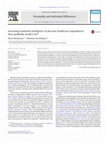
While numerous studies document the impact of emotional intelligence on health, no study has esti... more While numerous studies document the impact of emotional intelligence on health, no study has estimated the associated economic impact. As a result, the return on investment that could be expected from investing in improving emotional intelligence is unknown, and emotional intelligence research does not always make the expected impact on public policies. In this study, we examine how profitable it would be for governments or insurances to invest in improving people's emotional intelligence (EI). 9616 members of a Mutual Benefit Society completed a measure of EI that we coupled with their healthcare expenditures. Results first show that every 1% increase in intrapersonal EI corresponds to a 1% decrease in healthcare expenditures. Findings also show that the return on investment of increasing intrapersonal EI would vary as a function of people's educational level: the lower the level of education, the higher the expected return.
Psychoneuroendocrinology, 2008
Please cite this article in press as: de Timary, P., et al., Relationship between alexithymia, al... more Please cite this article in press as: de Timary, P., et al., Relationship between alexithymia, alexithymia factors and salivary cortisol in men exposed to a social stress test, Psychoneuroendocrinology (2008),
British Journal of …, Jan 1, 2009
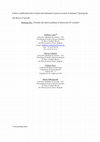
The neurohormone oxytocin (OT) has been one the most studied peptides in behavioral sciences over... more The neurohormone oxytocin (OT) has been one the most studied peptides in behavioral sciences over the past two decades. Primarily known for its crucial role in labor and lactation, a rapidly growing literature suggests that intranasal OT (IN-OT) may also play a role in humans’ emotional and social lives. However, the lack of a convincing theoretical framework explaining IN-OT’s effects that would also allow to predict which moderators exert their effects and when, has raised healthy skepticism regarding the robustness of human behavioral IN-OT research. The poor knowledge of OT’s exact pharmacokinetic properties, crucial statistical and methodological issues and the absence of direct replication efforts may have lead to a publication bias in IN-OT literature with many unpublished studies with null results lying in laboratories’ drawers. Is there a file drawer problem in IN-OT research? If this is the case, it may also be the case in our laboratory. This paper aims to answer that question, document the extent of the problem and discuss its implications for OT research. Through eight studies (including 13 dependent variables overall, assessed through 25 different paradigms) performed in our lab between 2009 and 2014 on 453 subjects, results were too often not those expected. Only five publications emerged from our studies and only one of these reported a null-finding. After realizing that our publication portfolio has become less and less representative of our actual findings and because the non-publication of our data might contribute to generating a publication bias in IN-OT research, we decided to get these studies out of our drawer and encourage other laboratories to do the same.
Lien vers le site d'auto-apprentissage des compétences d'aide mentionné dans le texte :
50-item questionnaire measuring intra-personal and inter-personal emotional competencies (identif... more 50-item questionnaire measuring intra-personal and inter-personal emotional competencies (identification, understanding, expression, regulation and use of emotions).
Merci pour le temps que vous consacrez à ce questionnaire et pour l'intérêt que vous y portez.
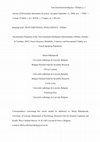
Intelligence Questionnaire (TEIQue, Petrides & Furnham, 2003) in a French-speaking population. In... more Intelligence Questionnaire (TEIQue, Petrides & Furnham, 2003) in a French-speaking population. In summary, we found that (1) TEIQue scores were globally normally distributed and reliable; (2) the UK four-factor structure (well-being, self-control, emotionality, sociability) replicated in our data; (3) TEIQue scores were dependent on gender but relatively independent of age; (4) there was preliminary evidence of convergent/discriminant validity, with TEIQue scores being independent of non-verbal reasoning (Raven's Matrices) but positively related to some personality dimensions (optimism, agreeableness, openness, conscientiousness), as well as inversely related to others (alexithymia, neuroticism); (5) there was also preliminary evidence of criterion validity, with TEIQue scores predicting depression, anxiety and social support as well as future state affectivity, and emotional reactivity in neutral and stressful situations (6) TEIQue scores were susceptible to socially desirable responding, however (7) TEIQue scores had incremental validity to predict emotional reactivity over and above social desirability, alexithymia, and the five-factor model of personality. Such results constitute encouraging preliminary findings in favour of the use of the TEIQue.
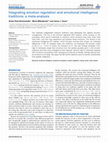
Frontiers in psychology, 2015
Two relatively independent research traditions have developed that address emotion management. Th... more Two relatively independent research traditions have developed that address emotion management. The first is the emotion regulation (ER) tradition, which focuses on the processes which permit individuals to influence which emotions they have, when they have them, and how they experience and express these emotions. The second is the emotional intelligence (EI) tradition, which focuses-among other things-on individual differences in ER. To integrate these two traditions, we employed the process model of ER (Gross, 1998b) to review the literature on EI. Two key findings emerged. First, high EI individuals shape their emotions from the earliest possible point in the emotion trajectory and have many strategies at their disposal. Second, high EI individuals regulate their emotions successfully when necessary but they do so flexibly, thereby leaving room for emotions to emerge. We argue that ER and EI traditions stand to benefit substantially from greater integration.
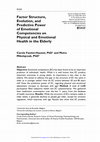
Journal of aging and health, 2014
Emotional competence (EC) has been found to be an important predictor of individuals' health.... more Emotional competence (EC) has been found to be an important predictor of individuals' health. While it is well known that EC predicts important outcomes in young adults, its importance is less clear in the elderly. We aimed to address this gap: Is the structure of EC the same in older as in younger adults? How do EC evolve between 50 and 80 years old? Does the predictive power of EC, regarding physical and emotional adjustment, increase or decrease with age? A total of 6,688 participants filled subjective health and EC questionnaires. We gathered their medication consumption over the last 11 years, from the database of health insurance. While the structure of ECs remains stable in older adults, it generally declines as people get older, except for emotion regulation, which improves with age. Results also show that EC predicts both physical and emotional health. These results suggest that the development of specific interventions to improve EC may be useful for the elderly.

L’Année psychologique, 2013
L'ocytocine (OT), une hormone polypeptidique bien connue pour son implication durant l'accoucheme... more L'ocytocine (OT), une hormone polypeptidique bien connue pour son implication durant l'accouchement, suscite depuis plus de deux décennies un intérêt sans cesse grandissant dans la communauté scientifique. Ces recherches ont permis de mettre en avant le rôle crucial de l'OT dans les processus psycho-sociaux. À tel point qu'elle a été élevée au rang d'hormone « pro sociale » par excellence. Mais cette réputation est-elle scientifiquement fondée ? L'OT est-elle vraiment l'hormone de l'amour décrite dans la presse populaire ? La revue de la littérature que nous avons menée vise à répondre à ces questions. Dans un premier temps, nous proposerons une revue exhaustive des différentes études menées sur l'OT. Nous fournirons dans un second temps un cadre interprétatif qui permettra de nuancer la vision que l'on se fait de l'OT à ce jour. Finalement, nous pointerons les failles présentes dans cette littérature et développerons certaines pistes de recherches pertinentes.
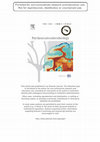
Psychoneuroendocrinology
The construct of trait emotional intelligence (trait EI) refers to the individual differences in ... more The construct of trait emotional intelligence (trait EI) refers to the individual differences in the perception, processing, regulation and utilization of emotional information. Several studies have found that trait EI was a significant moderator of subjective responses (e.g., mood deterioration, emotional intensity, action tendencies, bodily sensations) to both natural and laboratory stressors. The present study aims at extending these findings by examining whether trait EI also moderates the biological (i.e., cortisol) response to stress. To this end, 56 participants were assigned to either a neutral or a stressful condition (public speech task) and psychological and cortisol reactivity were examined. Results revealed that higher trait EI scores were associated with significantly lower reactivity to stress at both psychological (i.e., mood deterioration) and biological (i.e., salivary cortisol) levels. Additional analyses revealed that trait EI had incremental validity to predict ...
Psychoneuroendocrinology, 2010
…, 2008
Subjects reacted to the stressor with a significant cortisol response. Subjects scoring high on a... more Subjects reacted to the stressor with a significant cortisol response. Subjects scoring high on alexithymia evidenced an increased basal anticipatory cortisol level but their peak cortisol and area under the curve were similar to that of low scorers. Multiple regression analyses ...








Uploads
Papers by Moïra Mikolajczak